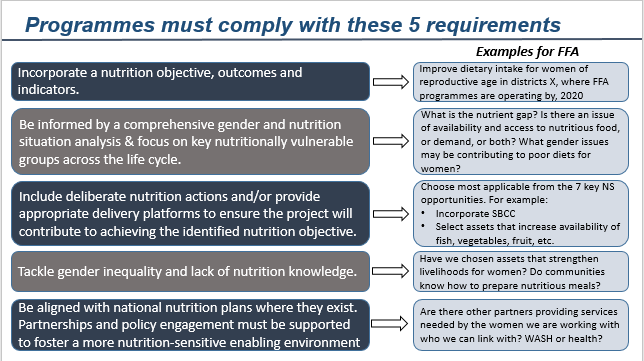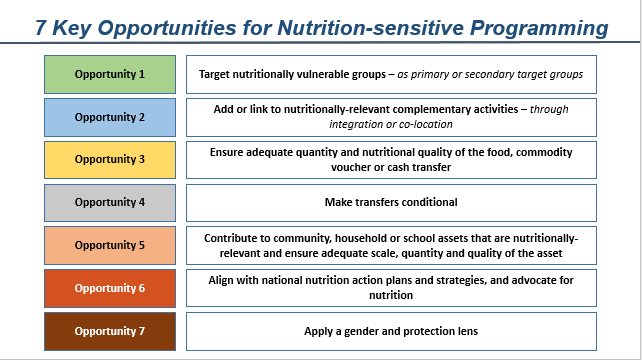What does nutrition-sensitive programming mean for WFP?
By Kathryn Ogden, Geraldine Lecuziat, Mutinta Hambayi, Quinn Marshall, Ali Elnawawi and Josephine Lofthouse (WFP nutrition team, Rome)
The WFP team acknowledge colleagues from IFPRI (Deanna Olney, Aulo Gelli, and Lilia Bliznashka) who supported the development of the programme impact pathways and seven opportunities. (Technical report: Making WFP’s Programmes More Nutrition-Sensitive).
Background
The new nutrition policy[1] of the World Food Programme (WFP) articulates its role in supporting governments to achieve Sustainable Development Goal (SDG) 2. It emphasises the need to integrate nutrition across WFP’s work in order to address the multiple burdens of malnutrition facing vulnerable groups. The potential impact of nutrition-sensitive programming in WFP is significant: WFP served 76.8 million people in 81 countries in 2015 (WFP, 2015), many of whom were in hard-to-reach places. The policy has three key messages:
- WFP can make a significant contribution to eliminating of all forms of malnutrition through nutrition-sensitive programming.
- Both nutrition-specific and nutrition-sensitive interventions are key in accelerating progress towards ending malnutrition in all its forms.
- Humanitarian nutrition-specific responses will remain a central feature of WFP’s work but are to be reinforced with nutrition-sensitive approaches.
This new policy reflects key changes in the global context. The 2013 Lancet Nutrition Series showed that implementing large-scale, proven, nutrition-specific interventions alone will only reduce stunting by 20% (Bhutta et al, 2013), leaving an 80% ‘black box’ which can only be addressed through nutrition-sensitive programming. We now know that one in three people globally is malnourished (IFPRI 2016), while 138 of 140 countries with data are facing single or multiple burdens of stunting among children, anaemia among women of reproductive age, or overweight among women (IFPRI 2016). Lastly, diet is the number one driver of the global burden of disease (Forouzanfar et al, 2015). WFP’s nutrition policy puts forward an integrated approach to nutrition that aims for adequate and healthy diets for vulnerable groups of all ages.
Nutrition-sensitive programming in WFP
Many of WFP’s programmes target poor and nutritionally vulnerable individuals and households and address immediate determinants of nutritional status (e.g. diet), as well as underlying determinants such as household access to food and care practices. WFP has identified four key programme areas that address some determinants of malnutrition:
- General food assistance.
- School meals, which reached 17.4m children in 2016.
- Smallholder agricultural market support programmes, which support smallholders to gain access to formal markets.
- Food assistance for assets, which addresses immediate food needs through cash, voucher or food transfers while promoting the building or rehabilitation of assets that will improve long-term food security and resilience.
A nutrition-sensitive food assistance for assets programme might, for example, build latrines or water points as the community asset; a school meals programme may involve building kitchen infrastructure or latrines; or cash transfers may be conditional on attending health centre check-ups. Improved water, sanitation and hygiene practices, care practices and knowledge may also be part of these programmes; all will be supporting improvements in dietary diversity and nutritional outcomes. In addition, through its partnerships with governments and others, WFP improves the enabling environment through supporting nutrition governance and policy formulation, multisector coordination, and better targeting, analysis and monitoring.
A nutrition-sensitive programme can also be used as a platform to scale-up nutrition-specific actions that address the immediate determinants of malnutrition. National social protection programmes, which are implemented on a large scale and target the most vulnerable people, also represent an important opportunity for delivering nutrition-sensitive programming.
For WFP, this means an organisational shift, broadening our nutrition focus beyond traditional treatment and prevention programmes beyond calories to nutrients. Programme colleagues will need support and guidance to do this.
Unlocking WFP’s potential: Guidance for nutrition-sensitive programming
Recently released WFP guidance, developed in partnership with IFPRI, aims to demystify what nutrition-sensitive means practically for WFP’s country office programmes. Programmes are encouraged to articulate how their interventions will influence nutrition outcomes by developing programme impact pathways which include inputs, activities and outputs and identify enabling and constraining factors and the means of addressing them. The guidance develops a set of minimum requirements (see Figure 1). Seven opportunities to increase nutrition-sensitivity across programmes have been identified (see Figure 2). The process to design nutrition-sensitive programmes is structured around four key steps following the logic of the project cycle:
- Understanding the nutritional situation for vulnerable life cycle groups and the drivers for malnutrition.
- Formulating and jointly planning the programme strategy across WFP sectors and key stakeholders and targeting nutritionally vulnerable groups.
- Selecting key opportunities to enhance nutrition-sensitivity of the programme.
- Measuring and monitoring progress and tracking unintended positive and negative effects.
Coordination and collaboration with government, partners and other sectors are essential within each step. WFP engagement with governments includes advocating for inclusion of nutrition-sensitive actions in national and/or sector strategies and developing joint annual action plans, facilitating links across ministries, and contributing to coordination platforms and fora.
Figure 1: Minimum requirements for nutrition-sensitive programming

Figure 2: Seven key opportunities for nutrition-sensitive programming

The WFP guidance outlines a pathway showing some of the linkages between inputs, activities, outputs, outcomes and impact, emphasising two critical mediating factors (gender equality and women’s empowerment as well as nutrition knowledge) and an enabling environment for sustainable progress and how WFP programming may influence nutrition.
WFP is committed to integrating gender equality and women’s empowerment into all its work. Beyond the importance of those outcomes in their own right, they also help to ensure that the nutrition needs of women, men, girls and boys are met. Nutrition-sensitive programme design and implementation should be gender-sensitive as a minimum requirement and, when possible, gender-transformative, with the aim of changing existing structural inequalities.
The Programme Impact Pathway helps country offices map out possible causal pathways to improved nutrition outcomes. The guidance also recognises the opportunity to improve communities’ nutrition knowledge; this may involve simpler messaging, education or social behaviour-change communication activity and can be delivered by WFP or a partner.
Securing uptake of the guidance
The guidance is being disseminated to programme colleagues in regional bureaux, country offices and headquarters. The nutrition-sensitive team in WFPs Nutrition Division are seeking feedback on the guidance and nutrition-sensitive programmes to ensure that it is refined over time with new evidence and best practices as well as the latest global evidence. We are also developing training materials to support its uptake.
The team is also seizing opportunities to influence country strategies and programmes. The development of WFP Country Office five-year Country Strategic Plans (CSPs) offer a key opportunity. The CSP, which is informed by a comprehensive analysis of the context in partnership with government and partners, defines WFP’s entire portfolio of assistance within a country, including strategic outcomes and activities for both protracted crises and humanitarian needs, as necessary. The CSP highlights how WFP supports countries to achieve national results and SDG targets focusing on SDG 2 and SDG 17. Bringing nutrition-sensitive analysis and planning in at this stage could make a tremendous difference to nutrition outcomes.
Nutrition colleagues within WFP would welcome your experiences in making organisations or programmes more nutrition-sensitive. We will be gathering evidence and case studies on our progress and look forward to sharing those with you.
For more information, contact: HQ.nutritionsensitive@wfp.org and/or kathryn.ogden@wfp.org
Footnotes
[1] http://documents.wfp.org/stellent/groups/public/documents/eb/wfp289329.pdf
References
Bhutta, et al, Evidence-based interventions for improvement of maternal and child nutrition: what can be done and at what cost? The Lancet, Volume 382, Issue 9890, 452-477.
Forouzanfar et al, 2015. Global, Regional, and National Comparative Risk Assessment of 79 Behavioural, Environmental and Occupational, and Metabolic Risks or Clusters of Risks in 188 Countries, 1990–2013: A Systematic Analysis for the Global Burden of Disease Study 2013. Lancet 386 (10010): 2287–2323.
IFPRI 2016. International Food Policy Research Institute. 2016. Global Nutrition Report 2016: From Promise to Impact: Ending Malnutrition by 2030. Washington, DC.
WFP 2015. World Food Programme Annual Report 2015.


